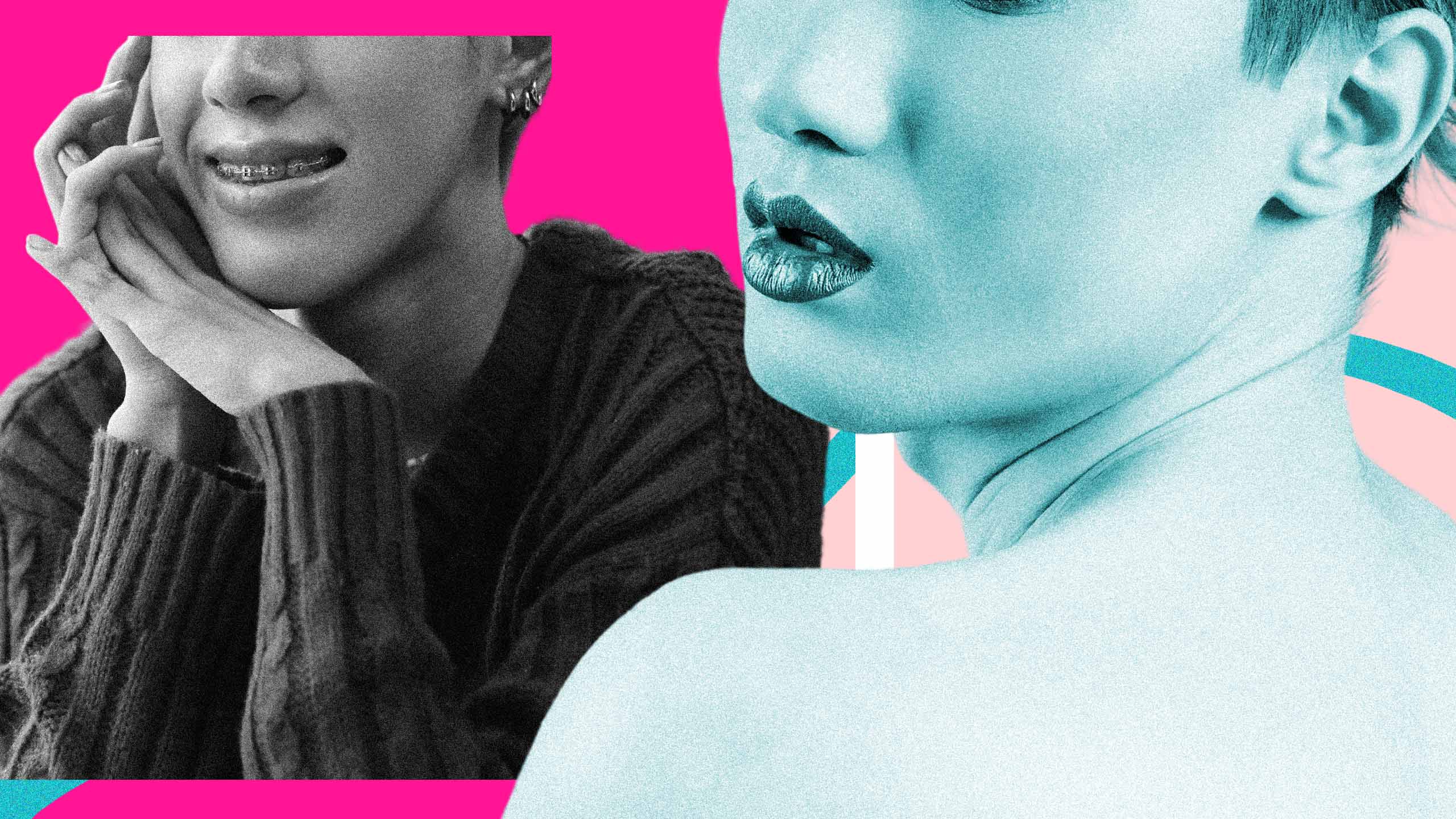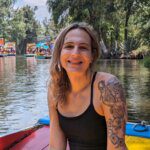The world first knew me through photographs. Many years ago, when the trauma and abuse I had experienced as a child was still strong in my body, I was terrified of telling anyone who I really was, and photos were the only way I could project myself into the world. I would dress up in women’s clothes and makeup, and take photo after photo, uploading the ones I liked best to online communities where I could get the validation and recognition that I needed so desperately.
I remember very clearly one where I was wearing a snug tank top and had given myself kitten eyeliner, and I had on a shoulder-length bob wig—I thought, oh my god, this is actually something someone would find real and desirable. The euphoria of that moment, of sharing that person with other human beings, even if mediated by a clunky web interface. It had felt so incredible.
I often ask myself why I just hadn’t known, right in that moment. It felt so absolutely blissful to be that person. So then why had it taken so many more years for me to finally accept that I should just be her permanently?
This was before trans people were widely known, before the internet was even really the internet that we now know. These websites were more akin to message boards than today’s social web, and the opportunities they offered for community were minimal. Still, even that much—compared to the absolute silence and isolation that I had known up until then—felt incredible.
Now that I’ve worked for years as a therapist and have done my own work in therapy, I understand these photos as the initial steps that I carried out in self-directed trauma work. This was before therapy was popularized and normalized, before there was availability of trans-competent clinicians who might help me conceptualize and deconstruct the stigma that I had always known, before being trans was something that was even mentioned outside the margins of seedy talk shows and obscure internet forums. Without other means of processing the traumas I had experienced throughout my life, I turned to my tripod, digital SLR and timed shutter release to help me see who I was—and to discover that not everyone in the world would find her repulsive.
At some point during these years I noticed myself becoming more and more fixated on the idea of taking the one perfect photo: an image of myself so perfectly womanly that—no matter how hard I tried—I could not see any trace of a man in it. Throughout the years of accepting myself, coming out to the world, making the decision to transition and finally living my truth, this idea of capturing that one perfect photo remained persistent and powerful. It took me so long to let go of it, and even today the echoes of that need still reverberate in my mind.
Sometimes I think about the years I spent trying to take that ideal photo and what exactly it was about. Probably the search for safety and validity in a world that has done so much to deny me both of those things, the desire to breathe easier and to not have to soothe the perpetual worry that others are reading traces of falseness into my being. Like, if I could just take that one perfect photo, it could protect me from having to be trans in a society that often acts as though it doesn’t want me to be here.
I want to be very, very clear that I have profoundly mixed feelings about the idea that looking or acting cis should be a means of safety-seeking or validation for us. Finding our place in this world is a multifaceted act, and there are many correct answers to this question, each with its own pros and cons. If I focus on physical appearance in this essay, it is because I know just how cruel, dehumanizing and violent the world can be to someone who does not meet its standards—particularly a woman who does not meet its standards. I approach this piece first and foremost as a vulnerable human being with a great deal of compassion for what I have been through.
In my years of serving the mental health of other trans people, I have seen many of us seeking the safety and inclusion that I want, and I’ve come to believe that just trying to exist as trans in this world may be a form of complex post-traumatic stress (CPTSD). First coined in the 1990s by the feminist scholar and psychologist Judith Herman, CPTSD is a cousin of the better-known post-traumatic stress disorder. The latter was first conceptualized when men coming back from wars were incapable of living a normal life—some horrible experience, like seeing a friend blown up in a bombing or being wounded themselves, had traumatized them to the point that they could no longer function.
Herman proposed CPTSD as emerging out of the experience of women who had survived ongoing traumatic situations, like chronic domestic abuse. Instead of there just being one horrific traumatizing event, she theorized that CPTSD occurs when someone is forced to live in an prolonged state of subjugation and deprivation, even if no single event rises to the horror of an occurance like being raped.
If the ongoing, daily abuses that many trans people experience in the form of family rejection and abuse, bullying, social ostracism and denial, and politically organized violence do amount to a form of complex trauma, then we might imagine coming out and transitioning—in effect, learning to live our truth in this world—as ways of healing. This, at least, has been my own experience.
In my practice as a mental health professional, I have learned that healing requires us to discover how to safely connect in the world. In fact, many major mental health challenges can be usefully construed as forms of radical disconnection. There are many ways of building back that safe sense of connection; I would argue that photographs are likely one of the safest and most broadly accessible. And, following this logic, I would imagine that this is one of the reasons why so many trans people have used photos so thoroughly in our processes. They are an essential way of reconnecting with the world that has scorned us, and thus taking steps in those paths of healing.
In my case, this thesis certainly holds true. For at least the first two years of my transition, I don’t believe a single day passed when I did not take selfies, often many, many of them. For the most part, these photos were not ever meant for anyone other than myself, although I did share many of the best of them with a real excitement, a sense of joy and liberation. They were attempts to capture a fleeting glimpse of who I really was, and then to project that out into the world.
Through the years of transition, as my body, mind and behaviour became more and more in line with who I knew myself to be, photos felt like a way to check in with the objective truth. I had the good fortune of passing fairly early in my transition, but even as the world came less and less to stare at me, to denounce me, to restrict me, to find me disgusting and not worthy of being human—even as the world less and less slighted me in these ways, I still hung tightly to my sense of hypervigilance, my ever-present fear that one wrong move could bring an avalanche of hatred, disgust and possibly violence down over me. That fear and hypervigilance were very damaging things to live with and caused me a lot of mental agony.
Photos helped me to remember what I actually looked like when the trauma took hold and wanted to trick my brain into imagining self-hating and self-defeating things. They helped me when, even after years of passing perfectly well for cis, the traumatized parts of my psyche held fast to the fear that no one could possibly really take me for a woman.
Of course, we know that the camera lies. It’s easy to access videos demonstrating exactly how much your face will warp as you move from a 105 mm lens to a 35 mm—and we all have used trial and error to discover the best angles to snap the most favourable selfie—but all things considered, photos were not a terrible way of grounding myself when I began to experience toxic doubt. And that grounding was really what I most needed. To get outside of the mindset that had been moulded over years of various forms of abuse, to the point where it was extremely hard to see myself as beautiful, feminine, desirable, cute or any of the many things that trans women are constantly told we will never be. Photos let me see a more objective truth, as opposed to the lies of a traumatized brain—they offered a crucial support to survive the mental storms that would hit on an almost daily basis throughout my transition—and still hit on a regular basis amid the ongoing onslaught of hate against trans people.
As I’m hoping is clear by now, I do believe that transition is much more of a mental process than a physical one. Medical science can do a great deal to provide us with a body that gives us the opportunity to live life as who we really are—but, to me, seeing that body as valid, and building within it a life worth living are the really hard parts. I’ve never met a medical doctor who has spoken at all to that part of our process.
One of the ways I’ve found most helpful to conceptualize CPTSD is as a catastrophic breach of trust with the world. CPTSD comes about because people such as our immediate family, our teachers, our close friends—those who should rarely, if ever, break our trust in any substantial way—end up doing exactly that so habitually and enormously that we find it virtually impossible to meaningfully trust in anything ever again. This is why I think CPTSD makes so much sense for our struggles. A thousand little daily points of stigma and denial, and soon enough I had internalized my own dehumanization, to the point where I didn’t trust myself. Recovering my own viewpoint and my own agency is how I have healed from this trauma.
Now that so much of my healing journey is behind me, I still find that photos play a necessary role in my healing. Around my home, I have many framed photos of myself doing things that have brought me joy, such as embracing my partner on the day I graduated from my master’s program, relaxing in my bikini on Waikiki Beach, or exploring Mexico City on a radiant summer day—and I look at them daily to help me remember that to the world I am just a normal woman doing normal things. Teaching myself to believe that I can just be a perfectly boring woman if I want to is a powerful act of healing.


 Why you can trust Xtra
Why you can trust Xtra


